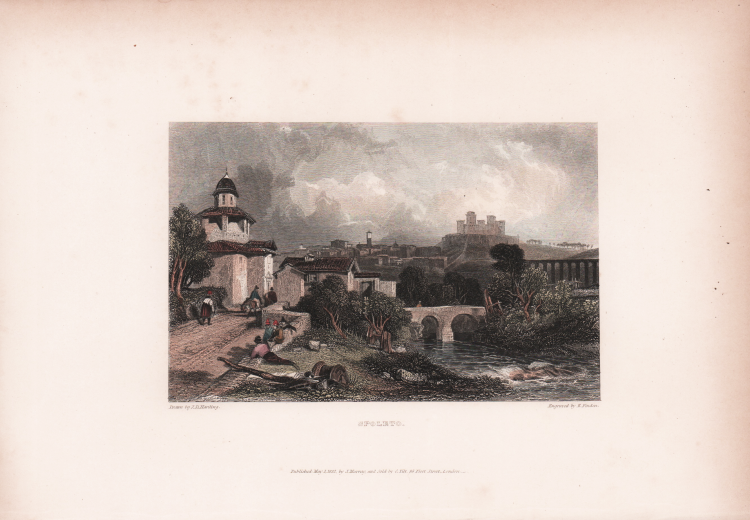


| Reference: | CO-794 |
| Author | William & Edward Francis FINDEN |
| Year: | 1833 |
| Zone: | Spoleto |
| Printed: | London |
| Measures: | 230 x 160 mm |


| Reference: | CO-794 |
| Author | William & Edward Francis FINDEN |
| Year: | 1833 |
| Zone: | Spoleto |
| Printed: | London |
| Measures: | 230 x 160 mm |
Veduta tratta da Finden's Illustrations of the Life and Works of Lord Byron. With Original and Selected Information on the Subjects of the Engravings di William Brokedon, pubblicato a Londra da John Murray, nel 1833.
Incisione in rame, finemente colorata a mano, in ottimo stato di conservazione.
William & Edward Francis FINDEN
|
William Finden (b London, 1787; d London, 20 Sept 1852) and his brother Edward Francis Finden (b London, 30 April 1791; d London, 9 Feb 1857) studied under the engraver James Mitan (1776–1822) and became specialists in small-scale book illustration, at first working for such publishers as John Sharpe ( fl 1801–30) but later building up their own business. They were much in demand for the minutely detailed plates carried by annuals and keepsakes, for which there was a vogue in the 1820s; the plates were engraved on steel, and large numbers could be printed. The first and most successful of their ventures was Finden’s Illustrations of the Life and Works of Lord Byron (1833–4). A series of publications followed, but their ambitious folio Finden’s Royal Gallery of British Art (1838–49) came at a time when the fashion for such works was faltering. William Finden also engraved a few large prints issued singly, for example after David Wilkie and Edwin Henry Landseer. His last large plate, the Crucifixion after William Hilton, was bought for £1470 by the Art-Union of London and distributed to subscribers.
|
William & Edward Francis FINDEN
|
William Finden (b London, 1787; d London, 20 Sept 1852) and his brother Edward Francis Finden (b London, 30 April 1791; d London, 9 Feb 1857) studied under the engraver James Mitan (1776–1822) and became specialists in small-scale book illustration, at first working for such publishers as John Sharpe ( fl 1801–30) but later building up their own business. They were much in demand for the minutely detailed plates carried by annuals and keepsakes, for which there was a vogue in the 1820s; the plates were engraved on steel, and large numbers could be printed. The first and most successful of their ventures was Finden’s Illustrations of the Life and Works of Lord Byron (1833–4). A series of publications followed, but their ambitious folio Finden’s Royal Gallery of British Art (1838–49) came at a time when the fashion for such works was faltering. William Finden also engraved a few large prints issued singly, for example after David Wilkie and Edwin Henry Landseer. His last large plate, the Crucifixion after William Hilton, was bought for £1470 by the Art-Union of London and distributed to subscribers.
|